|
The words: Blocks, Tables, Chain saw, Wire saw, Horizontal drilling, Air bag, or Kiln Drier are not part of the usual vocabulary of the average NZ Quarryman. In the dimension-stone business, however, these are some of the key words used to describe their processes and tools, so a few of us found out on a recent field trip, at a visit to Hinuera Stone.
Waikato Bay of Plenty IOQ branch simply put on another great field trip (June 2007). Groups coming from Thames, Paeroa, Tauranga, Matamata, Otorohanga, Te Kuiti, and the Auckland branch had an eye-opening day. Special thanks must go to our sponsors, who make these field trips possible: Here’s an overview of the day:
|
|
WINSTONE AGGREGATES WHITEHALL QUARRYFirst stop for the two bus loads of quarry enthusiasts was the Whitehall Quarry located approx 10km east of Cambridge off SH1. Their quarrying activities had been frustrated since 1999 when a ?greasy-back? on the south face adjacent to the No1 Pit let go, sending 50,000m3 or so of clay, rubble and rock slumping to the floor. In the last 7 years they have opened and methodically worked a second pit adjacent to the slip focusing on winning and processing rock suitable for their main client ? Firth Concrete.
|
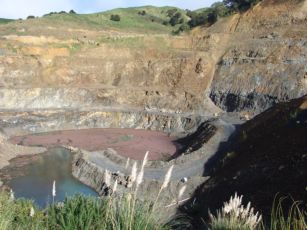 As you can see below us, the No 2 Pit now doubles as a water reservoir for washing processes.? As you can see below us, the No 2 Pit now doubles as a water reservoir for washing processes.?
Brent is now excited with their methodical approach. ?A new plant has replaced the old one which will increase production capacity from 250,000 to about 425,000 tonne per year.”
|
J SWAP TAOTAOROA QUARRY
?We’ve just recently made a few more upgrades including a second new hopper and primary crusher, and finally we have replaced the 150HP Barmac with a 300HP one. With a total throughput of approx 750,000 tonnes per year, and 450,000 tonne of this being sealing chip and concrete aggregates, the upgrades assures we have sufficient capacity for this. As fast as we make the sealing chips they’re gone.?
|
HINUERA QUARRY?Hinuera Stone? has for several generations been synonymous with the high-end market – that special cladding featured for those wanting something other than a bricked home. For those quarrying folk who have only heard about the dimension-stone industry, the trip to Hinuera Quarry was the highlight of the day. We’ll let the pictures do most of the talking. |
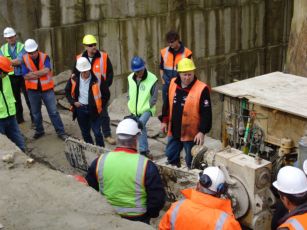 * Blocks of stone are cut vertically with a special 55mm wide hydraulically-operated 2.4m long chain saw equipped with special tungsten diamond teeth. In ?soft material? the chain saw can manage 20m per day, but in the hard stone accomplishes just 8m per day. * Blocks of stone are cut vertically with a special 55mm wide hydraulically-operated 2.4m long chain saw equipped with special tungsten diamond teeth. In ?soft material? the chain saw can manage 20m per day, but in the hard stone accomplishes just 8m per day.* Small explosive charges are placed into horizontal drill holes to ?cut? the base of the slab * Into the gap created by the chain-saw a 38mm air-bag is placed. When inflated a sideways pressure equivalent of 74 tonne assist moving the block away from the cut face * Each block when cut weighs approx 8 tonnes Each is transported to the factory area with a Komatsu 370 loader fitted with log-forks |
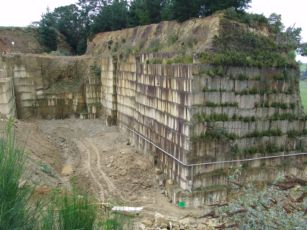 In the ?newer? quarry located just 40m or so north of the first pit, a diamond wire-saw is used to cut the rock. This is a quicker process and less wasteful with sawcut widths of just 10mm wide compared to the 55mm gaps when using the chainsaw * A crawler crane is used to sling the rock tables to where they can be picked up with the Komatsu loader. |
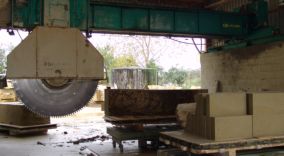 * In the processing area large circular saws are used to cut each block or table into size * In the processing area large circular saws are used to cut each block or table into size* A new Kiln-drying process is used to make a dark-brown coloured Hinuera stone which is proving quite popular in the market * Hinuera stone employs 25 people and one salesman To our tour guide – Basil (Bazz) Westlake, Hinuera Stone’s Site Manager, we all thank you for your patience and the enthusiastic manner you imparted your knowledge to give those of us in the aggregate game some insight into your dimension-stone business.
Just a great way to unwind after a fabulous lunch and an ale or three supplied by our hosts Les Ward and Jon McAllister of Metso Minerals Matamata. A great day for networking and learning. |

 ?For a quarry with a long-standing reputation for supply of Transit metal and sealing chips to many large contracts this has been hard times for Whitehall? explains Brent Graat, 24 yr old Trainee Production Supervisor. ?However there is now light at the end of the tunnel. After the slip came down we created a buttress to prevent further slippage of the face occurring by dumping overburden layers on top of the slip materials. The south wall is now benched and stable. That means that we can now commence processing the material from the buttress and opening up the base of the No 2 pit.
?For a quarry with a long-standing reputation for supply of Transit metal and sealing chips to many large contracts this has been hard times for Whitehall? explains Brent Graat, 24 yr old Trainee Production Supervisor. ?However there is now light at the end of the tunnel. After the slip came down we created a buttress to prevent further slippage of the face occurring by dumping overburden layers on top of the slip materials. The south wall is now benched and stable. That means that we can now commence processing the material from the buttress and opening up the base of the No 2 pit. “We’re also well under way to completing the stream diversion. That idea was first talked about in 1990 by Quarry Manager at that time, Ken Duncalfe and geologist John Ashby. Now 15 years on with all the consenting and environmental issues addressed, we’re hopeful in Sept or October this year that the channel and culvert works should be completed. The stream diversion will allow us access to and extraction of a large deposit of very hard blue greywacke. When this occurs Winstone Aggregates will again have a full range of products available to the market?
“We’re also well under way to completing the stream diversion. That idea was first talked about in 1990 by Quarry Manager at that time, Ken Duncalfe and geologist John Ashby. Now 15 years on with all the consenting and environmental issues addressed, we’re hopeful in Sept or October this year that the channel and culvert works should be completed. The stream diversion will allow us access to and extraction of a large deposit of very hard blue greywacke. When this occurs Winstone Aggregates will again have a full range of products available to the market? As can be seen in these photos the quarry pit is expansive with plenty of room on the surrounding land to the west for stockpiling.
As can be seen in these photos the quarry pit is expansive with plenty of room on the surrounding land to the west for stockpiling.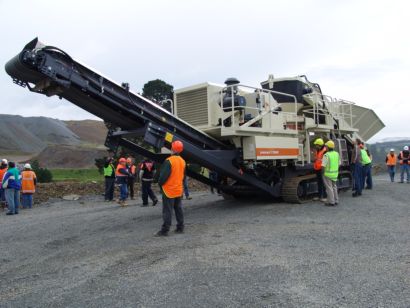 On display at Swaps quarry was the new crushing beast on tracks ? a Lokotrack LT200HP from
On display at Swaps quarry was the new crushing beast on tracks ? a Lokotrack LT200HP from 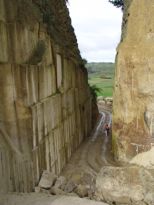 * Set in the hills a few km west of Matamata
* Set in the hills a few km west of Matamata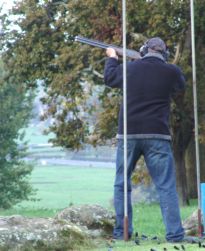 And for the relaxing piece-de-resistance ? many thanks to Jason and Paul Tidmarsh for arranging the clay skeet shooting at your ‘Red Barn’.
And for the relaxing piece-de-resistance ? many thanks to Jason and Paul Tidmarsh for arranging the clay skeet shooting at your ‘Red Barn’.